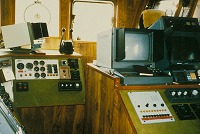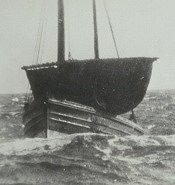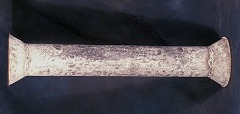Back to start | Human Dangers | Next
Life onboard: equipment

Many of the dangers faced by fishermen at sea do not come from external forces. They come instead from the day-to-day operating of powerful machinery in often unfavourable conditions. This is as true now as it was in the days of the sailing boats. The early sailing boats had no decks. The heavy sails and nets had to be worked with no mechanical assistance in a tossing boat. This needed specialist skills. Now, powerful equipment is used for propelling the boat and hauling gear. However, the fishermen must be well trained and adept in its use. The scale of machinery now used on fishing boats is difficult enough to operate on land, in a dry, covered yard. In the open sea, on a rolling vessel, often in the dark, it is far harder.

In the days of sail, all of the work was done by hand and there was little or no protective clothing available. The most dangerous tasks were raising or lowering the sail. Lug-rigged boats such as the fifie were used along most of the Scottish east coast. When the wind changed direction and when shooting or hauling the nets, the lug sail had to be lowered, lifted round the mast, and hoisted again on the new tack. This was known as tacking. Handling the sails required much skill and teamwork from of the crew. On a large boat, the process could take 10 minutes. In rough weather, dipping the lug was dangerous as the boat could lose power during the change and steering was difficult. Heavy seas could cause it to lurch violently and crew members could easily be thrown overboard. Tacking meant that ropes carrying large weights could be moving very quickly over pulleys or rollers and could easily catch an arm or finger.

Shooting lines was also hazardous as again, the baited hooks would be moving quickly over the side and could tear the fishermen's flesh. In some areas a smooth metal tube was used to slide the lines over so that they did not catch. Hauling a wet rope was also hard on the fishermen's hands. Sometimes a mast broke. In 1906 fishermen from Ferryden were injured in this way.
As fishing became more mechanised, the dangers on board grew. Fishermen were no longer handling the gear by hand. However, the introduction of power winches and derricks has meant that heavier gear can be carried. A rope being hauled by a steam capstan or winch is even more dangerous if it becomes caught around a limb. Men have lost fingers or an arm, or even been pulled overboard in this way. Sixty percent of fishing vessel accidents are caused by damage from on-board machinery. It is very important that fishermen ensure that all machinery is regularly serviced. The men operating it must also be fully trained and provided with the correct safety gear.
Back to start | Human Dangers | Next